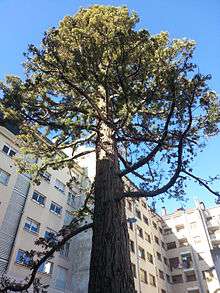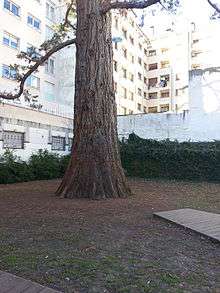The Great Sequoia

The Great Sequoia is an individual sequoia tree that is located in Vitoria-Gasteiz, the capital city of the Basque Country, and is a symbol of the city because of its enormous dimensions. It was declared as an individual tree by Decree 265, on 16 May 1995.
Location and measurements
The tree measures 40 meters of height, 8 meters of perimeter of trunk and 16 meters of crown. It is located in the back court of a public building at Magdalena street Nº12, close to Ursulinas's college and 200 meters from the Florida. It is the oldest living being of Vitoria-Gasteiz, having been planted in 1860 by D. Juan Ibarrondo.[1] It is one of the "Colossuses of Vitoria".
Endangerment and protection

The monumental sequoia of Vitoria-Gasteiz is surrounded by walls and buildings, bordering the court of the college. The Building work of the nearby block of housings damaged its roots, and deprived the tree of light. At one point, it was to be felled because its dimensions were perceived as a nuisance, but the Town Hall ruled that the large sequoia was not to be cut down. Because it was close to a school, some children's games contributed to trampling the soil. As consequence, the leaves started yellowing and the sequoia's condition started to become worrisome because some of the sequoias located on the Campillo de Deleitosa had been disappearing during the last years.
Subsequently, actions tending to protect the tree and to create a suitable environment for it began. The initial project was modified attending to the suggestions of the Deputation, competent in the management of the singular trees in Alava. A few platforms of wood supported on the soil were built to help aerate the soil, preventing visitors from walking through it. The rest of the space, most of the garden, was covered by plant remains to further prevent walking upon the soil.[1]
See also
References
- 1 2 Francisco Góngora (25 August 2010). "La gran secuoya cumple 150 años". El Correo (in Spanish). Retrieved 19 May 2014.